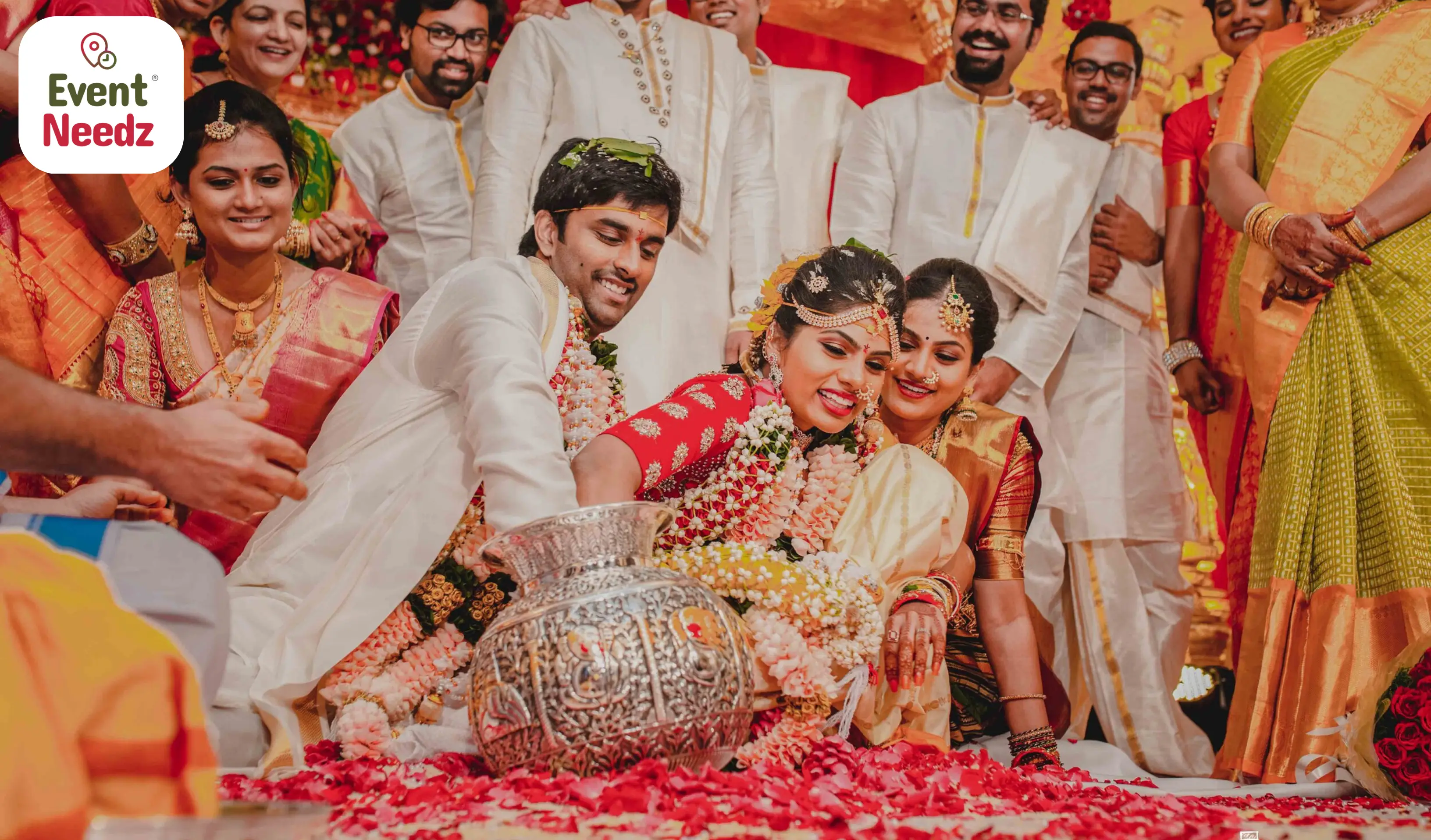Advertisement

Team @ EventNeedz
Uncovering the Beauty and Significance of a Traditional Telugu Wedding

A traditional Telugu wedding is a beautiful and meaningful celebration of love and union. With its rich cultural heritage and deep-rooted traditions, a Telugu wedding is a celebration of the couple's love and commitment and the love and support of their families.
This article will explore the various elements and rituals involved in a traditional Telugu wedding.
1. Muhurtham: The muhurtham selects an auspicious time and date for the wedding ceremony, determined by the families of the brides and grooms and a Hindu priest. This is considered significant because it is believed that the timing of the wedding can influence the success and happiness of the couple's marriage.
2. Snathakam: The snathakam is a ritual the groom performs to purify himself before the wedding ceremony. This ritual symbolizes the groom's commitment to living a pure and virtuous life with his bride.
3. Kashi Yatra: The Kashi yatra is a ritual the groom performs in which he symbolically renounces material possessions and worldly life. This ritual symbolizes the groom's commitment to the spiritual journey and his wife, who will now be his primary focus.
4. Gadwal: The gadwall is a ritual in which the groom is greeted at the bride's home by her family and friends. This is a joyous occasion that marks the beginning of the wedding festivities.
5. Jaimala: The jai mala is the exchange of flower garlands between the bride and groom, symbolizing their acceptance of each other. This ritual is significant because it represents the couple's willingness to embrace each other's strengths and weaknesses.
6. Kanyadaan: The kanyadaan is a ritual of giving away of the bride by her father to the groom, signifying that she is now under the care of her husband. This ritual is significant because it symbolizes the transfer of responsibility for the bride's well-being from her father to her husband.
7. Saat Phere: The saat phere are seven vows the bride and groom take in front of the sacred fire, symbolizing their commitment to each other. These vows involve promises to support each other, respect each other's families, and live a life of mutual love and respect.
8. Sindoor and Mangalsutra: The groom applies sindoor to the hair partition of the bride and ties the mangal sutra around her neck, signifying that she is now married. These rituals are significant because they symbolize the couple's union and the start of their married life together.
9. Aashirwad: The aashirwad is a blessing given to the couple by the elders of both families. This blessing is significant because it signifies the support and well-wishes of the couple's families as they embark on their new life together.
10. Reception: A reception is usually held following the wedding ceremony, where the couple is introduced to their friends and extended family. This joyous occasion celebrates the couple's union and allows everyone to come together to wish them well.
The importance of the wedding rituals is explained here:
1. Jeelakarra Bellam, also known as Jeelakarra and Jeera, is a significant item used in traditional Telugu weddings. It combines cumin seeds (jeera) and jaggery (bellam). It is considered a symbol of married life's sweetness and bitterness. The couple must often eat the mixture together to symbolize their commitment. In some communities, the Jeelakarra Bellam ritual is performed during the wedding ceremony. In contrast, in others, it is performed during the engagement ceremony. In either case, the practice is symbolic of the couple's willingness to face the challenges of married life together and to embrace both the sweet and bitter moments that come their way. The Jeelakarra Bellam ritual is significant because it represents the couple's commitment to each other and their shared journey through life. It is believed to bring lots of good luck and prosperity to the couple and to ensure a long and happy marriage.
2. Talambralu is a traditional ritual performed at Telugu weddings. During this ritual, both, the bride and groom are showered with rice by their family members and friends to symbolize good luck and prosperity. The rice used in this ritual is usually raw, uncooked rice, believed to bring wealth and abundance to the couple's new life together. The talambralu ritual is considered significant because it is a celebration of the couple's new life together and a symbol of their love and support from their families and friends. It is also believed to bring umpteen good luck and prosperity to the couple and to ensure a long and happy marriage.
3. The mangalsutra typically consists of a chain with a pendant made of gold or other precious metals and is often decorated with diamonds or other gemstones. It is usually tied around the bride's neck by the groom during the wedding ceremony. It is considered to be an important symbol of the couple's union. In addition to symbolizing the couple's love and commitment, the mangalsutra also holds religious significance in Hinduism. It is believed to protect the bride from evil spirits and to bring her blessings and good fortune. The mangalsutra is worn by the bride for the rest of her life and is considered an essential jewelry item representing her status as a married woman.
4. The Basikalu ritual on the forehead is a traditional practice in Telugu weddings where a red or yellow string is tied on the forehead of the bride and groom. This string is usually decorated with turmeric, vermilion powder, or other auspicious items. It is said to bring the couple loads of good luck and prosperity. The Basikalu on the forehead is usually tied by the bride, the groom's mother, or a close relative. It symbolizes the couple's union and the support of their families. The Basikalu is considered an essential jewelry item and is usually worn for a few days after the wedding. It is believed to bring the couple good fortune and blessings in their new life together.
5. The significance of toe rings in Telugu culture can be traced back to ancient Hindu texts, which are mentioned as a symbol of the married woman's union with her husband. Toe rings are believed to bring good luck and prosperity to the couple and to help maintain a solid and harmonious relationship. In addition to their symbolic significance, toe rings are also believed to have health benefits. According to Ayurveda, wearing toe rings can stimulate pressure points on the feet, improving overall health and well-being.
In conclusion, a traditional Telugu wedding is a beautiful and meaningful celebration of love, union, and cultural heritage. From the Mangalasutram ceremony to the significance of toe rings, each aspect of the wedding holds great symbolic importance and represents the couple's love, commitment, and union.
The use of traditional elements, such as Basikalu and Mattelu, adds to the beauty and grandeur of the event and creates a memorable experience for all those involved. By understanding the significance of each ritual and tradition, couples can make a Telugu wedding that is not only a celebration of their love but also a celebration of their cultural heritage and family traditions.
With platforms like Event Needz, couples can easily connect with the right vendors to supply the traditional wedding accessories they need to make their special day a reality. Whether you are planning a conventional Telugu wedding or simply curious about this rich cultural tradition, this article has provided valuable insights and information to help you create a celebration of love and commitment that will be remembered for years.
About
A blog is an online Article or informational website displaying information in reverse chronological order, with the latest posts appearing first, at the top. It is a platform where a writer or a group of writers share their views on an individual subject.

Advertisement



 Google
Google  Facebook
Facebook 






